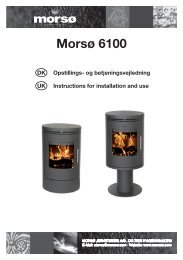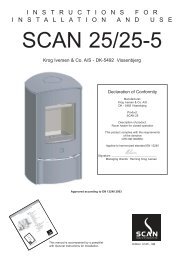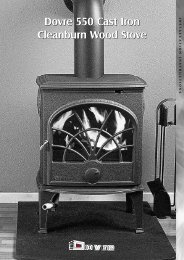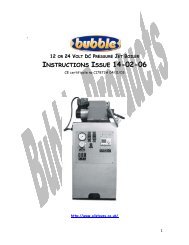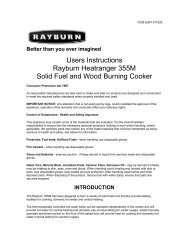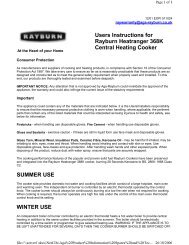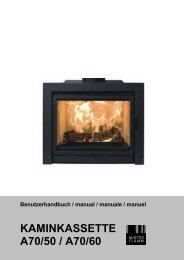potted history of rayburn solid fuel cookers post - Harworth Heating Ltd
potted history of rayburn solid fuel cookers post - Harworth Heating Ltd
potted history of rayburn solid fuel cookers post - Harworth Heating Ltd
You also want an ePaper? Increase the reach of your titles
YUMPU automatically turns print PDFs into web optimized ePapers that Google loves.
1. INTRODUCTIONRayburn <strong>solid</strong> <strong>fuel</strong> <strong>cookers</strong> can, cook, heatwater, heat the kitchen, be <strong>fuel</strong>led by almostanything and when used and maintainedproperly, last a lifetime.What else could you possible want?They look great, they are easy to cleanexternally and the cast iron ovens are selfcleaning.Food cooked on Rayburn’s tastes wonderfulland some models can be used when there iseither no power or a power cut.It’s easy to see why the lovely <strong>cookers</strong> havebeen so popular for so long.<strong>Harworth</strong> <strong>Heating</strong>2. IDENTIFICATIONTHE NO 1The Rayburn Number 1 was the firstgeneration <strong>of</strong> 'Rayburn' cooker, introducedin 1946 and manufactured up to about 1958,when it was largely superceded by theintroduction <strong>of</strong> the Rayburn RegentBoth Old and New pattern had a single ovenand was available as a L.H. or R.H. ovenversion. The No. 1 is distinguished byhaving no insulating lid covering thehotplate.Each version had an optional boiler, whichwith 24 hours continuous burning, producedapproximately 90,000BTUs (26kW). Bothappliances required connection to a 30gallon hot water storage cylinder, either on adirect or indirect system. Alternatively anoptional side-tank could be used.The difference between the two models is inthe fire and ashpit doors. The old patternhad independent doors, whereas the newpattern had interlocking doors, where theashpit door cannot be opened before thefiredoor is opened.The firebricks were the same for eachmodel, but some were changed when built asnon-boiler versions - the boiler versionhaving a rectangular fire-grate and the nonboilera circular grate.The other feature that changed on thesemodels was the riddling method. This wasoriginally done by opening the ashpit door,but on later models outside riddling wasintroduced, requiring an alteration to thebottom side bricks to accommodate it.The cast iron boiler was referred to as the12" boiler and was available with sidetappings or top tappings.Optional extras available for adding tothe basic appliance were:-1. Loose insulating lid.2. Splash-back and plate-rack3. Plate-rack only4. Splashplate (low skirting)5. Handrail and brackets6. Oven thermometer7. Copper boiler8. Low pressure side tank <strong>of</strong> 17.5 gallons,for where no hot water storage system wasavailable.1






